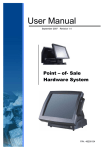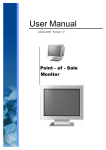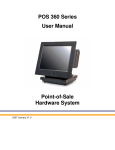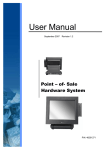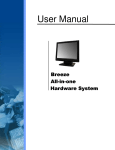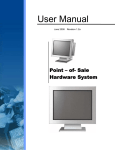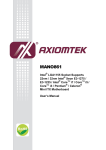Download Intel 4127 Computer Hardware User Manual
Transcript
User Manual September 2007 Revision 1.1 Kiosk Hardware System P/N: 48201201 User’s Manual Copyright 2007 Sep. All Rights Reserved Manual Version 1.1 The information contained in this document is subject to change without notice. We make no warranty of any kind with regard to this material, including, but not limited to, the implied warranties of merchantability and fitness for a particular purpose. We shall not be liable for errors contained herein or for incidental or consequential damages in connection with the furnishing, performance, or use of this material. This document contains proprietary information that is protected by copyright. All rights are reserved. No part of this document may be photocopied, reproduced or translated to another language without the prior written consent of the manufacturer. TRADEMARK Intel®, Pentium® and MMX are registered trademarks of Intel® Corporation. Microsoft® and Windows® are registered trademarks of Microsoft Corporation. ELO Touch is the registered trademark of ELO Touch Systems. 1 User’s Manual Safety IMPORTANT SAFETY INSTRUCTIONS 1. To disconnect the machine from the electrial power supply, turn off the power switch and remove the power cord plug from the wall socket. The wall socket must be easily accessible and in close proximity to the machine. 2. Read these instructions carefully. Save these instructions for future reference. 3. Follow all warnings and instructions marked on the product. 4. Do not use this product near water. 5. Do not place this product on an unstable cart,stand,or table.The product may fall, causing serious damage to the product. 6. Slots and openings in the cabinet and the back or bottom are provided for ventilation;to ensure reliable operation of the product and to protect it from overheating. These openings must not be blocked or covered.The openings should never be blocked by placing the product on a bed, sofa, rug, or other similar surface.This product should never be placed near or over a radiator or heat register,or in a built-in installation unless proper ventilation is provided. 7. This product should be operated from the type of power indicated on the marking label.If you are not sure of the type of power available, consult your dealer or local power company. 8. Do not allow anything to rest on the power cord. Do not locate this product where persons will walk on the cord. 9. Never push objects of any kind into this product through cabinet slots as they may touch dangerous voltage points or short out parts that could result in a fire or electric shock. Never spill liquid of any kind on the product. CE MARK This device complies with the requirements of the EEC directive 89/336/EEC with regard to “Electromagnetic compatibility” and 73/23/EEC “Low Voltage Directive”. FCC This device complies with part 15 of the FCC rules. Operation is subject to the following two conditions: (1) This device may not cause harmful interference (2) This device must accept any interference received, including interference that may cause undesired operation. 2 User’s Manual CAUTION ON LITHIUM BATTERIES There is a danger of explosion if the battery is replaced incorrectly. Replace only with the same or equivalent type recommended by the manufacturer. Discard used batteries according to the manufacturer’s instructions. LEGISLATION AND WEEE SYMBOL 2002/96/EC Waste Electrical and Electronic Equipment Directive on the treatment, collection, recycling and disposal of electric and electronic devices and their components. The crossed dustbin symbol on the device means that it should not be disposed of with other household wastes at the end of its working life. Instead, the device should be taken to the waste collection centers for activation of the treatment, collection, recycling and disposal procedure. To prevent possible harm to the environment or human health from uncontrolled waste disposal, please separate this from other types of wastes and recycle it responsibly to promote the sustainable reuse of material resources. Household users should contact either the retailer where they purchased this product, or their local government office, for details of where and how they can take this item for environmentally safe recycling. Business users should contact their supplier and check the terms and conditions of the purchase contract. This product should not be mixed with other commercial wastes for disposal. 3 User’s Manual Revision History Revision Number Description Revision Date 1.0 Initial Release. 2006 September 1.1 Cover page updated 2007 September 4 User’s Manual Table of Contents 1. Item Checklist.............................................................................................. 6 1.1. Standard Items ....................................................................................... 6 1.2. Optional Items ........................................................................................ 7 2. System View ................................................................................................ 8 2.1. Front View .............................................................................................. 8 2.2. Side View ............................................................................................... 9 2.3. Rear View............................................................................................. 10 3. Driver Installation .......................................................................................11 3.1. Driver List ..............................................................................................11 3.2. Chipset Driver Installation......................................................................11 3.3. USB 2.0 Driver Installation ................................................................... 13 3.4. VGA Driver Installation ......................................................................... 16 3.5. Audio Driver Installation........................................................................ 18 3.6. ELO Touch Driver Installation ............................................................... 19 3.7. POS Touch Driver Installation............................................................... 22 3.8. 10/100Mb LAN Driver Installation......................................................... 25 3.9. MiniPCI IEEE802.11g WLAN Driver Installation ................................... 26 3.10.FTP637 Thermal Printer Driver Installation ......................................... 27 4. System Disassembly................................................................................. 32 4.1. Removing the HDD Drive Bracket........................................................ 32 4.2. Replacing the HDD & Fan .................................................................... 33 4.3. Replacing the Mini PCI......................................................................... 34 4.4. Replacing the Power Adapter............................................................... 35 4.5. Replacing the Speakers ....................................................................... 36 4.6. Replacing the Motherboard .................................................................. 36 4.7. Replacing the Heatsink & CPU............................................................. 38 4.8. Replacing the Side Fan ........................................................................ 38 4.9. Replacing the LCD Panel & Touch Screen........................................... 39 4.10. Replacing the Touch Board & Inverter Board ..................................... 42 4.11. Replacing the Laser Scanner ............................................................. 43 4.12. Replacing the Card Reader & Thermal Printer................................... 43 5. Specification.............................................................................................. 45 6. Connectors and Jumper Settings............................................................ 47 7. BIOS Settings ............................................................................................ 54 Appendix A - Airflow Requirements................................................................ 57 5 User’s Manual 1. Item Checklist Take the system unit out of the carton. Remove the unit from the carton by holding it by the foam inserts. The following contents should be found in the carton: 1.1. Standard Items a. System b. Manual c. Driver CD d. Power Cable 6 User’s Manual 1.2. Optional Items a. Omni-directional Laser Scanner b. 3” Thermal Printer c. Swipe Magnetic Card Reader d. Mini PCI Wireless Card 7 User’s Manual 2. System View 2.1. Front View Swipe Magnetic Card Reader Laser Scanner 3” Thermal Printer Button Insert Type Card Reader 8 User’s Manual 2.2. Side View Key Lock Power Button USB Line In Line Out LAN DC Jack 9 User’s Manual 2.3. Rear View External COM cable External LAN cable 10 User’s Manual 3. Driver Installation 3.1. Driver List Folder/File File Description <CD>:\K81X_B76.htm B76 Driver List <CD>:\COMMON\INTEL\Chipset Chipset Driver <CD>:\COMMON\INTEL\USB 20 USB 2.0 Driver <CD>:\COMMON\INTEL\VGA\i85x VGA Driver <CD>:\COMMON\Ac97_codec\Realtek\ALC202A Audio Driver <CD>:\COMMON\Elo_Touch ELO Touch Driver <CD>:\COMMON\POS_Touch POS Touch Driver <CD>:\COMMON\Lan_driver\R8139_810x 10/100Mb LAN Driver <CD>:\COMMON\Wireless_LAN\802.11g\Inprocomm MiniPCI IEEE802.11g _IPN2220 Wireless LAN Driver <CD>:\COMMON\printer\FTP637 FTP637 Thermal Printer Driver -The following procedures are for Windows 2000/XP, other platforms are similar. 3.2. Chipset Driver Installation a. Double click “infinst_enu_6.0.1.1002” on the My computer window. b. Click the “Next” button on the Welcome window. 11 User’s Manual c. Click the “Yes” button on the License Agreement window. d. Click the ”Next” button on the Readme Information window. e. Click the “Finish” button and restart your system. 12 User’s Manual 3.3. USB 2.0 Driver Installation OS Requirements OS USB 2.0 requirements Windows XP USB 2.0 drivers are provided in Service Pack 1 (SP1) for Windows XP, which is available through Windows Update. Windows 2000 USB 2.0 drivers are available through Windows Update or Service Pack 4. Windows 98SE/Me USB 2.0 drivers are available on the Intel developer site. Windows 98 (Retail) Developers and OEMs should contact Orange Ware. For end-users, if your device does not ship with Windows 98 drivers, contact your device or system manufacturer. If USB 2.0 drivers are not available, your device will operate at USB 1.1 speeds Linux USB 2.0 support is available in kernel 2.4.19 or later development kernels, or in the 2.4.19 or later production kernel. More information. a. Right click My Computer on the desktop and select “properties” 13 b. Select “Hardware”à”Device Manager” on system properties. User’s Manual c. Select ”Other Devices” à “Universal Serial Bus (USB) Controller” à”Properties” on Device Manager. d. Select “Device”à “Update Driver…”. e. Click the ”Next” button on the welcome window. 14 User’s Manual f. Select “Search for a suitable…”and click the “Next” button on the Install Hardware Device Drivers window. g. Select “Specify a location” and click the “Next” button on the Locate Driver Files window. h. Press “Browse” to select driver and then click the “OK” button to go to the next page. i. 15 Click the “Next” button on Driver Files Search Results window. User’s Manual j. Click the “Finish” button to complete this process. k. Finished. 3.4. VGA Driver Installation a. Double click “win2k_xp147” on the My Computer window. b. Click the “Next” button on the Welcome window. 16 User’s Manual c. Click the ”Next” button on the Welcome window. d. Click the ”Yes” button on the License Agreement window. e. Click the ”Finish” button and restart your system. 17 User’s Manual 3.5. Audio Driver Installation a. Click “A3.71” on the My Computer window. b. Double click “wdm_a371” on the My Computer window. c. Click “Next” button on the Realtek AC’97 Audio Setup window. d. Click “Yes” button on the Digital Signature Not Found window. e. Click “Finish” button on the Realtek AC’97 Audio Setup window. 18 User’s Manual 3.6. ELO Touch Driver Installation a. Click ”sw500930” on the My computer window. b. Click the “OK” button on the Welcome window. c. Click the ”Unzip” button on the WinZip Self-Extractor window. d. Select “Install Serial Touchscreen Drivers” and then click the “Next” button on the Welcome window. 19 User’s Manual e. Click the “Yes” button on the License Agreement window. f. g. Select “COM5” and click the “Next” button on the Choose the COM ports… window. h. Click the “Next” button on the You have selected the COM ports…window. 20 Click the “Next” button on the on the “Select the COM ports…” window. User’s Manual i. Click the “Finish” button on the Setup Complete window j. k. After the computer has restarted, click “Align” on the Elo Touchscreen Properties window. Click the “Yes” button and restart your system. l. Follow the instructions on the screen to calibrate the touch panel. 21 User’s Manual 3.7. POS Touch Driver Installation a. Double click the ”Setup” on the “My Computer” window. b. Click the “Next“ button on the “Welcome window”. c. Click the ”Yes” button on the “License Agreement” window. d. Click the ”Next” button on the “Choose Destination Location” window. e. Click the “Next” button on the “Select Program Folder” window. f. Click the “Finish” button on the “Install Shield Wizard Complete” window. 22 User’s Manual g. Click the “Continue Anyway “ button on the “Hardware Installation” window. h. Select the “Yes” and click the ”OK” button and restart your system. i. After the computer has restarted, select “Programs àTouchUtility àScan RS232 Touch Device”. j. The serial ports are scanned for a touch device. k. Select “Programs àTouchUtility àTouch Utility”. l. Click “Scale / Offset” on the POSTouch Utility window. 23 User’s Manual n. Select “Device à9Pts Calibration” on the POSTouch Utility window. m. Follow the instructions on the screen to do a three point calibration of the touch panel. o. Follow the instructions on the screen to do a nine point calibration of the touch panel. 24 User’s Manual 3.8. 10/100Mb LAN Driver Installation a. Double click ”Setup” on the My Computer window. b. Click the “Finish” button on the Maintenance Complete window. c. Click the ”OK” button and restart your system. 25 User’s Manual 3.9. MiniPCI IEEE802.11g WLAN Driver Installation a. Double click the ”Setup” on the “My Computer” window. b. Click the “Next” button on the “Welcome to the InstallShield Wizard for G101_G231 Driver & Utility” window. c. Click the “Next” button on the “License Agreement” window. d. Click the “Install” on the “Ready to Install the Program” window. 26 User’s Manual e. Click the “Finish” on the “InstallShield Wizard Completed” window. 3.10. FTP637 Thermal Printer Driver Installation a. Click “ FTP637_Win2K_XP_V1020 ” on “My Computer” window. b. Type extract path: C:\Documents and Settings\Desktop. Click “Extract” button on the “7-Zip self-extracting” window. 27 User’s Manual c. The file name is FTP673 on the desktop. d. Select “Printers and Faxes”. e. Select “Add a printer” on the “Printer and Faxes” window. f. Click “Next” on the “Add Printer Wizard” window. 28 User’s Manual g. Select “Local printer attached to this computer” and click “Next” button on the “Add Printer Wizard” window. h. Select “Use the following port LPT1” and click “Next” button on the “Add Printer Wizard” window. i. Click “Have Disk” button on the “Add Printer Wizard” window. j. Click “Browse” button and select the file path: C:\Documents and Settings\Desktoo\FTP673. Then, click “OK” button. 29 User’s Manual k. Click “Next” button on the “Add Printer Wizard” window. l. Click “Next” button on the “Add Printer Wizard” window. m. Select “No” and click “Next” button on the “Print Test Page” window. n. Click “Finish” button on the “Add Printer Wizard” window. 30 User’s Manual o. Click “Continue Anyway” button on the “Hardware Installation” window. p. The printer driver installation is completed. 31 User’s Manual 4. System Disassembly 4.1. Removing the HDD Drive Bracket a. Remove the screws (5). b. Open the main housing to separate it from the base chassis, taking care not to stretch the cables which are still connected. (K811 showed in the picture.) c. Disconnect the fan cable (1). d. Loosen the screws (2) to lift the HDD bracket up. 32 User’s Manual Note: Please insert the HDD bracket into the slot at the middle of the rubber as shown in the picture. e. Pull the pull tape to disonnect the cable (1) from the motherboard. Remove the HDD bracket. 4.2. Replacing the HDD & Fan To replace the HDD and fan, please first follow the steps in chapter 4.1. a. Remove the HDD bracket. b. Remove the screws (4) to replace the HDD. 33 User’s Manual c. Remove the screws (2) to replace the fan. 4.3. Replacing the Mini PCI To replace the Mini PCI, please first follow the steps in chapter 4.1. a. Disconnect the antenna (2). b. To remove the Mini PCI card, release the two metal latches as shown in the picture until the card pops up. Remove the Mini PCI card from the slot. 34 User’s Manual 4.4. Replacing the Power Adapter To replace the power adapter, please first follow the steps in chapter 4.1. a. Disconnect the power cable (1). b. Disconnect the DC Jack cable (1). c. Remove the screw (1) to replace the power adapter. 35 User’s Manual 4.5. Replacing the Speakers To replace the speakers, please first follow the steps in chapter 4.1. a. Disconnect the speaker cable (1). b. Remove the screws (4) (two on each side) to replace speakers (2). 4.6. Replacing the Motherboard To replace the motherboard, please first follow the steps in chapter 4.1. a. Disconnect the cables (5): antenna cables (2), inverter cable (CN1), speaker & MIC cable (CN7), and LCD interface cable (CN12) (Refer to 6.1. B76 Motherboard). b. Disconnect the cables (8) on the daughter board: 100pin cable (CN1), COM 2 cable (CN3), COM3 cable (CN4), COM4 cable (CN5), LPT cable (CN7), speaker out cable (CN8), input power cable (CN12), and output for DC converter cable (CN13) (Refer to 6.5. Daughter Board Connectors). 36 User’s Manual c. Disconnect the power cable (1). d. Disconnect the cable (2): DC Jack cable (1) and LAN cable (1). e. Remove the screws (2). f. Remove the screws (3) to remove the EMI shielding box. g. Disconnect the fan cable (1). h. Remove the screws (6) to replace the motherboard. 37 User’s Manual 4.7. Replacing the Heatsink & CPU To replace the heatsink and CPU, please first follow the steps in chapter 4.6. a. Remove the screws (4) that secure the heatsink. b. Turn the knob 180 degrees to open the key lock to remove the CPU. 4.8. Replacing the Side Fan To replace the side fan, please first follow the steps in chapter 4.6. a. Disconnect the fan cable (1) on the motherboard. b. Remove the screw (1). 38 User’s Manual c. Remove the screws (2) to replace the side fan. 4.9. Replacing the LCD Panel & Touch Screen To replace the LCD panel and touch screen, please first follow the steps in chapter 4.1. a. Disconnect the cables (2): printer power cable (1) and card reader cable (1). b. Disconnect the cable (4): antenna cables, inverter cable (CN1), and LCD interface cable (CN12). 39 User’s Manual c. Disconnect the cables (3): COM3 cable (CN4), COM4 cable (CN5), and LPT cables (CN7). d. Remove the screw (1). e. Remove the screws (2). f. Remove the screws (2). g. Remove the screw (1). h. Pass the cables through the hole. 40 User’s Manual i. Use a screwdriver to carefully press in the four slots to pry off the display cover. Separate the LCD panel and touch screen. Take care not to stretch the touch cable which is still connected. j. Remove the screws (2). k. Remove the screws (2). l. Separate the LCD rear cover and LCD panel. Pass the cables through the hole. m. Disconnect the touch cable to separate the touch screen and LCD panel. 41 User’s Manual 4.10. Replacing the Touch Board & Inverter Board To replace the touch board and inverter board, please first follow the steps in chapter 4.9. a. Disconnect the touch cable (1). b. Remove the screws (2) to replace the touch board. c. Disconnect the cables (3). d. Remove the screws (2) to replace the inverter board. 42 User’s Manual 4.11. Replacing the Laser Scanner To replace the laser scanner, please first follow the steps in chapter 4.1. a. Remove the screw (1). b. Remove the screw (1) to replace the laser scanner. 4.12. Replacing the Card Reader & Thermal Printer a. Remove the screws (2). b. Push the button to open the cover. 43 User’s Manual c. Remove the screws (4) to take the module up. d. Remove the screws (2) to replace the card reader. e. Remove the screws (3) to replace the printer control board. 44 User’s Manual 5. Specification Mainboard CPU Supports Chipset System Memory Graphic Memory LCD Touch Panel LCD Size Brightness Maximal Resolution Touch Screen Type Tilt Angle (Degree) Storage HDD Flash Memory Expansion Mini-PCI Socket External I/O Ports Line in (Audio) Line out (Audio) USB LAN (10/100) COM Internal Speaker DC Jack Control / Indicator Power Button Wall Mount Type VESA Standard Power Power Adapter Peripherals Hybrid Card Reader B76 Intel Celeron M 1.3GHz Intel 852GM + ICH4 1 x DDR SO-DIMM socket supported with memory size up to 1 GB Shared Memory up to 64MB 12.1" TFT 425 cd/㎡ 800 x 600 Resistive 80° ~ 90° Slim 2.5” HDD Compact Flash (Type I & II) 1 1 1 2 (V 2.0) 1 (RJ45) 1 (Option 2 COM ports) 2 x 2W 1 (19V IN) 1 75 x 75 mm / 100 x 100 mm Internal 65W (19V / 3.42A) Internal 120W (19V / 6.3A) N/A Three-track MSR or optional IC / smart card reader 45 User’s Manual Magnetic Card Reader Laser Scanner Thermal Printer Wireless LAN Environment EMC & Safety Operating Temperature Storage Temperature Operating Humidity Storage Humidity Dimension (W x D x H mm/inch) OS Support 3 Track (PS/2) N/A Omni-directional (RS-232) N/A 3” internal thermal printer with auto-cutter 802.11a/b/g wireless support via mini-PCI Adapter FCC, Class A, CE, LVD 5℃ ~ 35℃ (41℉ ~ 95℉) -10℃ ~ 60℃ (14℉ ~ 140℉) 20% - 90% RH non condensing 20% - 90% RH non condensing 298 x 134 x 397 mm / 11.7” x 5.3” x 15.6” Microsoft Windows XP Professional, Windows XP Embedded, Windows 2000, WEPOS - This specification is subject to change without prior notice. 46 User’s Manual 6. Connectors and Jumper Settings B76 Motherboard CN1 CN2 JP2 JP1 JP3 IDE1 CF1 JP4 DIMM1 CN3 JP5 CN4 CN7 CN8 CN9 CN10 JP6 F3 F4 CN12 JP7 JP8 CN13 CN14 PWR1 CN19 JP9 CN20 PWR2 47 RJ45 AUX1 AUX2 USB1 CN17 CN21 User’s Manual 1. Connectors Connector Function Connector Function CN1 Inverter CONN CN20 CN2 LED CN21 Power Connector For Extend COM Port Programmable Keyboard CN3 USB5/6 F3 CPU FAN CONTROL CN4 LINE-IN CONN F4 CN7 Speaker & MIC CONN DIMM1 SYSTEM FAN CONTROL DDR Memory CN8 I-Bottom CONN IDE1 2.5” IDE Device CN9 Support VFD PWR1 PWR CONN CN10 Card Reader Connector PWR2 DC JACK CN12 LCD Interface RJ45_1 LAN Connector CN13 CF1 CF CARD CONN CN14 100 pin Connecter to IO Board COM5 CONN for Touch AUX1 LINE OUT CN17 Power Switch AUX2 MIC IN CN19 For Power/LAN LED CONN USB1 USB 3 / USB4 port 2. Jumper Settings 1. CMOS Operation Mode Function JP1 CMOS Normal ◎N/C CMOS Reset 1-2 To clear the CMOS: 1) Remove AC power from the unit. 2) Open the cabinet. 3) Change the JP1 jumper setting from N/C to 1-2. 4) Wait 1 minute. 5) Change the JP1 jumper setting back to N/C. 6) Close the cabinet. 7) Apply AC power and continue. 48 User’s Manual 2. Compact Flash Master / Slave Setting Function JP5 Master ◎1-2 Slave N/C 3. Power Mode Setting Function JP7 ATX Power ◎N/C AT Power 1-2 4. I-Button Setting Function JP8 Use I-Button N/C No I-Button ◎1-2 3-4 5. LCD ID Setting Panel Resolution Number 0 640 x 480 Bits 18 LVDS JP6 Channel 1-2 3-4 5-6 7-8 Single SHORT SHORT SHORT SHORT 1 800 x 600 18 Single SHORT SHORT SHORT 2 1024 x 768 18 Single SHORT SHORT OPEN SHORT 3 1280 x 1024 24 Dual SHORT SHORT OPEN OPEN 4 1024 x 768 24 Single SHORT OPEN SHORT SHORT 5 800 x 600 24 Single SHORT OPEN SHORT 6. Programming Keyboard Setting Function JP9 Use P-KB N/C No P-KB ◎1-2 3-4 49 OPEN OPEN User’s Manual 3. Connectors Pin Definition CN1: Inverter CONN Pin 1 +12V_INV Pin 3 +12V_INV Pin 5 VRSET Pin 7 GND Pin 2 Pin 4 Pin 6 Pin 8 +12V_INV BKLEN GND GND CN3: USB 5 / USB 6 Pin 1 +5V_USB 4 Pin 3 USB20_R_P4+ Pin 5 +5V_USB 5 Pin 7 USB20_P5+ Pin 2 Pin 4 Pin 6 Pin 8 USB20_R_P4GND USB20_P5GND CN4: Line-In CONN Pin 1 GND Pin 3 LINE_IN_L Pin 2 Pin 4 LINE_IN_R GND CN6: 4 Wire Touch Pin 1 ESD 1 Pin 3 ESD 3 Pin 2 Pin 4 ESD 2 ESD 4 CN7: Speaker & MIC CONN Pin 1 AMP_ORL Pin 3 GND Pin 5 GND Pin 2 Pin 4 Pin 6 GND AMP_ORR MIC 1 CN9: Support VFD Pin 1 +12V Pin 3 RS232_4_RX# Pin 2 Pin 4 RS232_4_TX# GND 50 User’s Manual CN10: Card Reader Connector Pin 1 +5V Pin 3 KDATA_SIO_TO_MSR Pin 5 KDATA_MSR_TO_IBT Pin 7 RS232_CR_RX# Pin 9 RS232_CR_CTS# Pin 11 KB_EN Pin 13 USB 20_MSR_P4+ Pin 15 GND Pin 2 Pin 4 Pin 6 Pin 8 Pin 10 Pin 12 Pin 14 +5V KCLK_SIO_TO_MSR KCLK_MSR_TO_IBR RS232_CR_TX# RS232_CR_RTS# GND USB20_MSR_P4+ CN11: Internal Touch Pin 1 ESD 1 Pin 3 ESD 2 Pin 5 ESD 3 Pin 7 ESD 4 Pin 9 ESD 5 Pin 11 NC Pin 2 Pin 4 Pin 6 Pin 8 Pin 10 Pin 12 ESD 1 ESD 2 ESD 3 ESD 4 ESD 5 NC CN12: LVDS Interface Pin 1 LVDS_B0+ Pin 3 LVDS_B0Pin 5 GND Pin 7 LVDS_B1+ Pin 9 LVDS_B1Pin 11 GND Pin 13 LVDS_B2+ Pin 15 LVDS_B2Pin 17 GND Pin 19 LVDS_B3+ Pin 2 Pin 4 Pin 6 Pin 8 Pin 10 Pin 12 Pin 14 Pin 16 Pin 18 Pin 20 LVDS_A3+ LVDS_A3GND LVDS_CLKA+ LVDS_CLKAGND LVDS_A2+ LVDS_A2GND LVDS_A1+ 51 User’s Manual CN12: LVDS Interface Pin 21 LVDS_B3Pin 23 GND Pin 25 LVDS_CLKB+ Pin 27 LVDS_CLKBPin 29 GND Pin 31 +5V_LCDVDD Pin 33 +5V_LCDVDD Pin 35 +5V_LCDVDD Pin 37 +5V_LCDVDD Pin 39 +5V_LCDVDD Pin 22 Pin 24 Pin 26 Pin 28 Pin 30 Pin 32 Pin 34 Pin 36 Pin 38 Pin 40 LVDS_A1GND LVDS_A0+ LVDS_A0GND +3.3V_LCDVDD +3.3V_LCDVDD +3.3V_LCDVDD +3.3V_LCDVDD +3.3V_LCDVDD CN14: COM 5 CONN for External Touch Pin 1 RS232_5_DCD# Pin 2 Pin 3 RS232_5_TX# Pin 4 Pin 5 GND Pin 6 Pin 7 RS232_5_RTS# Pin 8 Pin 9 RS232_5_RI Pin 10 RS232_5_RX# RS232_5_DTR# RS232_5_CTS# RS232_5_CTS# +5V CN16: USB 4 Pin 1 +5V_USB3 Pin 3 USB20_P3+ Pin 2 Pin 4 USB20_P3GND CN18: USB 3 Pin 1 +5V_USB2 Pin 3 USB20_P2+ Pin 2 Pin 4 USB20_P2GND CN19: For Power/LAN LED CONN Pin 1 GND Pin 2 Pin 3 LAN_LINK# +5V CN20: Power Connector For Extend COM Port Pin 1 +12V Pin 2 GND Pin 3 GND Pin 4 +5V 52 User’s Manual 5. Daughter Board Connectors CN5 CN7 CN4 CN3 CN2 CN11 CN12 CN1 CN10 CN13 FAN1 CN14 CN9 Connector Function Connector Function CN1 CN8 Speak out CN2 100pin Connector to I/O Board COM1 CN9 MIC CN3 COM2 CN10 MSR CN4 COM3 CN11 USB CN5 COM4 CN12 +12V / +5V Input Power CN6 Speaker & MIC CONN (Input) LPT Port CN13 +12V / +5V Output for DC Converter Power Connector for 3.5” HDD CN7 CN6 CN14 53 CN8 User’s Manual 7. BIOS Settings 1. BIOS Setup Utility The BIOS setup defines how the system is configured. You need to run this program the first time you configure this product. You may need to run it again if you change the configuration. You need to connect a PC keyboard to the keyboard connector to run the BIOS setup utility. 2. Starting the BIOS Setup 1. Turn on or reboot this product. 2. Press the DEL key immediately after the product is turned on, or press the DEL key when the following message is displayed during POST (the Power on Self-Test). Press DEL to enter SETUP. 3. The main menu of the BIOS setup is displayed. 4. If the supervisor password is set, you must enter it here. 3. When a Problem Occurs If, after making and saving system changes with the Setup utility, you find that this product no longer boots, start the BIOS setup and execute the following. Load Optimized Defaults 4. BIOS Main Menu When the BIOS Main Menu is displayed, the following items can be selected. Use the arrow keys to select items and the Enter key to accept and enter the sub-menu. Note: The BIOS menu below is from B76 BIOS version B76MV10.BIN. If you have a different BIOS version, the contents of the menu may different. 54 User’s Manual Standard CMOS Features Use this menu for basic system configuration. Advanced BIOS Features Use this menu to set the Advanced Features available on the system. Advanced Chipset Features Use this menu to change the values in the chipset registers and optimize the system’s performance. Integrated Peripherals Use this menu to specify your settings for integrated peripherals. Power Management setup Use this menu to specify your settings for power management. PnP/PCI Configurations This entry appears if your system supports Plug and Play and PCI Configuration. PC health status Displays CPU, System Temperature, Fan Speed, and System Voltages Value. Load Optimized Defaults Use this menu to load the BIOS default values, i.e., factory settings for optimal performance system operations. While Award has designed the custom BIOS to maximize performance, the factory has the option to change these defaults to meet their needs. 55 User’s Manual Set Supervisor Password Enables you to change, set, or disable the supervisor or user password. Set Password Change, set, or disable the password. It allows you to limit access to the system and to the setup, or just to the setup. Save & exit setup Save CMOS value changes to CMOS and exits setup. Exit without saving Ignores all CMOS value changes and exits setup. 56 User’s Manual Appendix A - Airflow Requirements Do not block the air vents on the terminal. These vents are necessary for cooling purposes. Do not place the terminal in an enclosed area where sufficient ventilation is not available. Leave at least 150 mm (6 in) of clearance on the sides where air vents are located. 57



























































